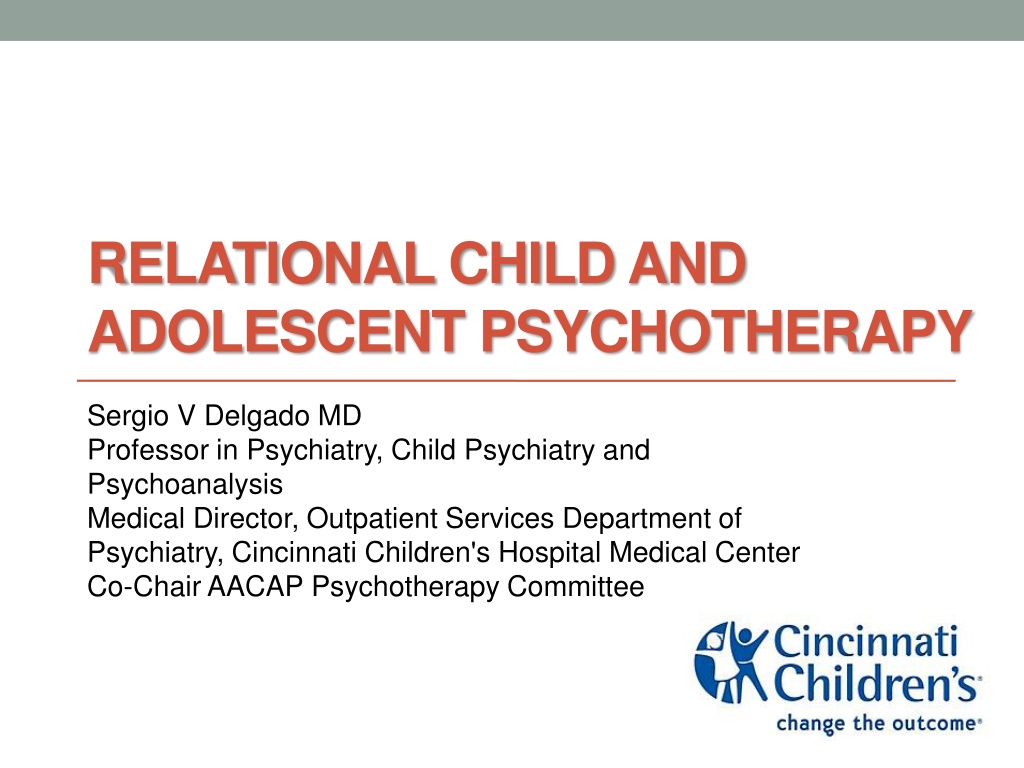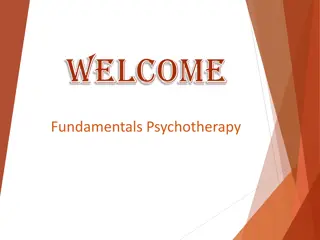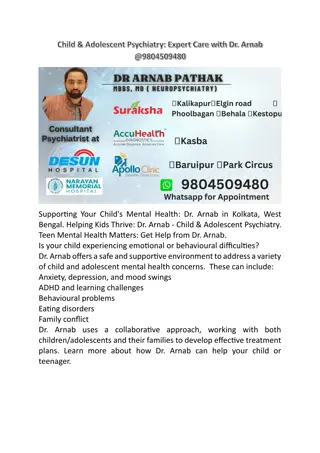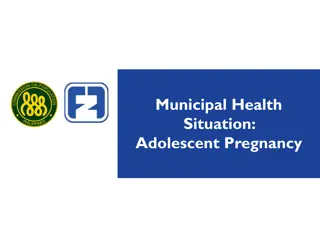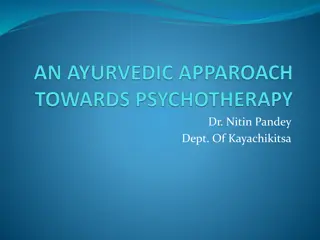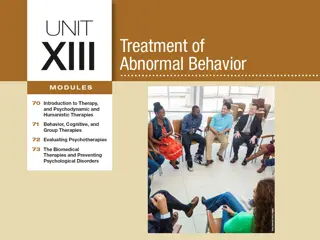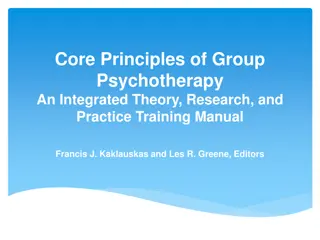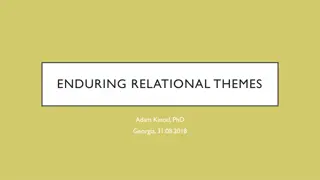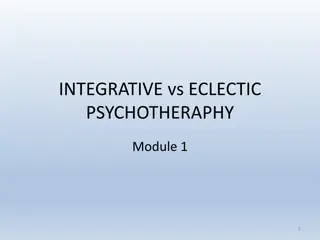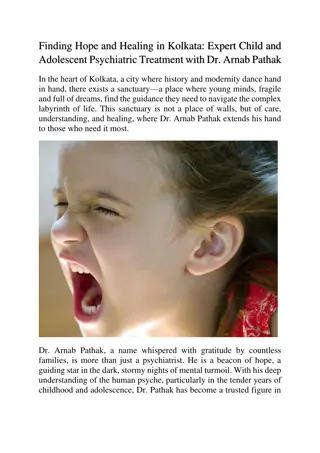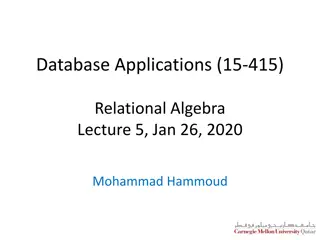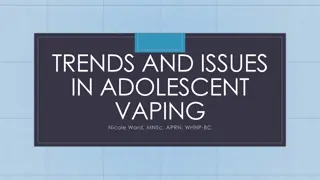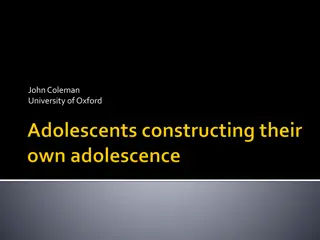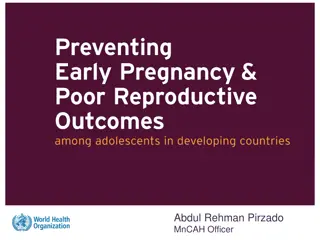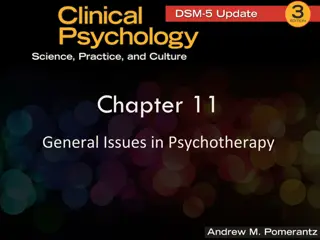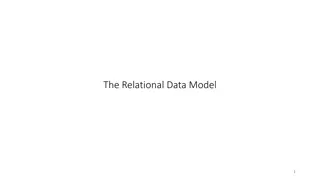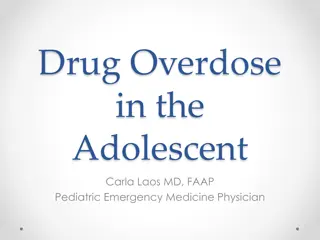Understanding Relational Child and Adolescent Psychotherapy
Explore the concepts of relational child and adolescent psychotherapy involving attachment patterns, intersubjectivity, corrective emotional experiences, and the role of the relational psychodynamic psychotherapist in providing corrective emotional experiences essential for the child's development. Incorporating developmental research and Tronick's still-face experiments.
Download Presentation

Please find below an Image/Link to download the presentation.
The content on the website is provided AS IS for your information and personal use only. It may not be sold, licensed, or shared on other websites without obtaining consent from the author. Download presentation by click this link. If you encounter any issues during the download, it is possible that the publisher has removed the file from their server.
E N D
Presentation Transcript
RELATIONAL CHILD AND ADOLESCENT PSYCHOTHERAPY Sergio V Delgado MD Professor in Psychiatry, Child Psychiatry and Psychoanalysis Medical Director, Outpatient Services Department of Psychiatry, Cincinnati Children's Hospital Medical Center Co-Chair AACAP Psychotherapy Committee
CLINICAL CONCEPTS IN RELATIONAL CHILD AND ADOLESCENT PSYCHOTHERPAY IMPLICIT RELATIONAL KNWOING Attachment patterns with others INTERSUBJECTIVITY Interplay between therapist and the patient s subjective experience CORRECTIVE EMOTIONAL EXPERIENCE Co-creation of new neuronal pathways PSYCHOTHERAPY A meaning-making process, does not follow universal laws Buirski and Haglund (2009)
Still-Face Experiments Meta-analyses confirmed that higher maternal sensitivity predicted more infant positive affect during the still-face. Infants higher positive affect and lower negative affect during the still-face were predictive of secure attachment at 1 year of age. Incorporate developmental research into relational psychodynamic psychotherapy Ed Tronick UMASS
Relational Child and Adolescent Psychotherapy Bowlby distanced himself from Freud s drive theory concepts, as he believed that infants have a pro-social innate wish to be with and to get along with others. This has been supported by a wealth of infant developmental research, with strong evidence of processes in infants as: meaning making, social referencing, affective attunement, internal working model schemas, dynamic non-conscious implicit relational knowing. Tronick s remarkable still-face experiments, that capture the many efforts an infant can resort to in re-engaging with their caregiver. (Suggest YouTube clips)
The relational psychodynamic psychotherapist The relational psychodynamic psychotherapist, gives importance to the context of the child s reality, as it allows to know which type of corrective emotional experiences are needed to provide to the child, to be stored in implicit relational memory and non-conscious, and are utilized in future and more adaptive interactions.
Genetic developmental blueprint Developmental research has provided evidence regarding the complex processes in the scaffolding of physical and psychological competencies over time and of different body regions, not derived from instinctual drives but rather bio-genetic developmental influences. Recent cross-cultural research suggests that it is difficult to delineate the transition from one developmental phase to another. Thus, the phases preoedipal, oedipal, latency and adolescence are somewhat artificial. The child s genetic developmental blueprint is strongly influenced by family and environmental factors, which are interwoven and can act synergistically to promote further development (Delgado et al., 2010).
Mirror Neurons The subjectivity of others return to state of happiness
Contemporary Diagnostic Interview (CDI) Formal Psychiatric Disorder Summary 4 year old boy who presents with functional impairment timed with struggles that began when his environment became unpredictable. Symptoms of anxiety and oppositional defiant disorder although does not meet full DSM-IV or DSM-5 criteria Internal Working Models of Attachment (IWMA) Treatment plan Recommendation for individual psychotherapy in a relational perspective, a therapeutic dyad to co- create new adaptive experiences and provide a corrective emotional experience. Anxious/Dismissive Temperament Mixed; Easy/Flexible with Feisty/Difficult Cognition Below Average Delgado SV, Strawn JR, Pedapati E (2015) Cognitive and Affective Flexibility Contemporary Psychodynamic Psychotherapy for Children and Adolescents Springer Limited sense of agency
Temperament styles Thomas and Chess (1960,1977) defined three general types of temperament styles: 45% easy or flexible 15% slow-to-warm-up 10% as difficult or feisty 35 % mixed, a combination of the three
Cognitive, psychological and social milestones For instance, neurologically we know that walking is a milestone that children can reach between the ages of 9 and 12 months in a securely attached environment. For the child that grows in an environment of disorganized attachments, the child typically learns to walk at an earlier age for survival need to access food or using mobility to distance themselves from violent situations. Recently, the news media shared a story about a 2 year old child smoking marijuana while her mother recorded the event. In the video (accessible via YouTube,) the child demonstrates knowing how to hold and smoke the marijuana joint, which had been stored in implicit procedural relational memory. Therefore, the relational psychodynamic psychotherapist will need to know the cognitive, psychological and social milestones appropriate for the age of the child seen in psychotherapy.
Developmental Milestones: Four to Six Year Old Developmental Milestones: Four to Six Year Old Developmental Domain Concerning Proficient Social/Emotional Restricted range of emotions Ignores other children or doesn t respond to people outside the family Shows extreme behavior (unusually fearful, aggressive, shy or sad) Doesn t play a variety of games and activities No interest in make-believe or interactive games Difficulty distinguishing pretend from real Enjoys doing new things, may bore quickly of old toys or games Increasing creativity with make-believe play Wants to please and agrees to rules Increasingly cooperates and plays with other children Likes to sing, dance, and act By 5, can tell difference between pretend and real By 5, aware of gender May be demanding at times and compliant at other times Language/Communic ation Speaks unclearly Cannot retell favorite story or video Frequent errors with pronouns Unable to comment on daily activities or experiences Limited and repetitive vocabulary Poor use of grammar, especially plurals and past tense Sings a song or poem from memory Tells stories with full sentences Can say first and last name Increasingly uses future tense Uses basic rules of grammar By 5, recites alphabet and counts to 10 By 6, average expressive vocabulary should be 2,500 words and receptive vocabulary should be 20,000 words Cognition Has trouble scribbling Resists dressing self and toilet training Difficulty staying focused on single activity for more than 5 minutes Cannot follow 3-part commands By 6, identifies colors and numbers Can draw a person and geometric shapes with increasing complexity Can count 10 or more things Developing idea of same and different Remembers parts of stories and tells what may happen next Knows about things used every day, like money and food Division of Birth Defects, National Center on Birth Defects and Developmental Disabilities, Centers for Disease Control and Prevention; Shelvov SP. et al ,(2004). The American Academy of Pediatrics: Complete and Authoritative Guide for Caring for Your Baby and Young Child. Bantam Books.
The We-go Research indicates that from infancy, innately given brain processes support social reciprocity and the development of we-ness . It is through the we-ness that internal working models for self-regulatory functions are formed by mirror and echo neuron systems into neuronal pathways of adaptive social reciprocity. The We-go (Robert N Emde 2009)
Regulatory schemas There is an implicit non-conscious social sense of morality that occurs as early as 9 months as the infant interprets the different expectations and intents of others. Relational psychotherapy proposes that infants engage with other humans for comfort and survival and the wish to remain civil morality-. The regulatory schema is not due to the repression of the aggressive wishes emanating from the Id.
Oedipal Conflicts? It is well known that sexual development is a complex process, no longer understood by Freud s drive theory Genotypic gender, phenotypic gender, gender identification, and sexual orientation are distinct from one another but interrelated. (Kandel 1999) Standard terms such as male, female, masculine, and feminine are imprecise and are in need of qualification. (Kandel 1999) This is an area that remains in fluidity, as it also pertains to children who live with lesbian, gay, bisexual and transgender parents
Implicit relational memory In relational psychotherapy, the unconscious phenomena are thought to be dynamic and non- conflicted. It is comprised of meaning-making process and internal regulatory interpersonal schemas stored in non-declarative memory in the form of implicit relational memory. The Preverbal Self
Implicit relational memory Example: When speaking to a young child, our implicit memory allows us to know what tone of voice and affect is needed to maintain the jovial conversation (motherese) and allow the child to feel we are attuned to them. Our tone of voice and affect will change quickly if we simultaneously speak to the child s parents. This shift in knowing what tone of voice and affect is needed, is not bound by the unconscious as previously thought, but by the implicit non- conscious relational memory
Intersubjectivity It is the dynamic interplay between the therapist and the patient and their subjective experiences to one another. Is considered contextual and idiosyncratic to the particular clinical interaction. This is considered the primary force of the treatment process.
Fantasy In relational psychotherapy, fantasy is a concept that is seen as representing the non-conflicted creative and imaginative abilities of the child or adolescent. This ability persists into adult life as confirmed by popular fantasy literature Allan Poe, Lewis Carroll, Mary Shelley, L. Frank Baum, J.K. Rowling, etc--and films Disney, Spielberg, etc. -- which have been popular in many cultures. Fantasy role-playing games, i.e. Dungeons & Dragons --the first tabletop role-playing game also represents creativity with appeal to broad audiences. Therefore, in childhood imagination and fantasy, is a cognitive meaning making process, a form of interpersonal communication that does not abide by the norms of reality and is influenced by culture.
Implicit Relational Knowing Implicit procedural memory leads to implicit relational knowing, which contributes to why people seek accomplices to that which is familiar. Unfortunately, children who are raised in a chaotic and abusive environment, form disorganized patterns of attachment, which are then repeated in their intimate relationships to others and may unwittingly cause them to get involved with someone who mistreats or abuses them, similar to their original caregivers. People who have disorganized attachment patterns often choose negative situations which are familiar over positive situations which are unfamiliar, many survivors of childhood abuse or neglect equate love and affection with trauma. Lyons-Ruth K, et al 1998
Implicit Procedural Memory A child s oppositional behavior occurs at an implicit level. They have seen a caregiver or another person refuse to participate in an activity they did not master, perhaps even reading or playing with others. The Boston Change Process Study Group eloquently states, With this rich new view of all that happens in interactive and affective life, we would replace the idea of conflict between tripartite structures with this more dyadic view of complex patterns of conflict between the intentional directions of the self and the intentional directions of important others that are represented at the implicit level.
Basic Premises in Relational psychotherapy The dyadic nature of the therapeutic process Fittedness and directionality in the therapeutic process Sloppiness and creative negotiation in the therapeutic process Increasing inclusiveness of the therapeutic process Vitalization in the therapeutic process The Boston Change Process Study Group
Well thought out enactments and timed self-disclosures In child and adolescent psychodynamic psychotherapy, the clinician will need to: allow for the co-creation of well thought out enactments and timed self-disclosures which promote a corrective emotional experience in the here and now moments of intersubjectivity. Working with parents intersubjectively is also essential.
Corrective emotional experience Corrective emotional experience -- teaching the importance in using motherse with rhythmicity and intonation and match the physical movements made by the child. From a maladaptive model of relating with others to a new adaptive model co-created in the here and now that allows for a new narrative in the non- conscious implicit memory systems A relational approach provides a wider range of possible implicit relational problems in understanding parent s reactions to their child, if part of a vulnerable population, i.e. (chronic medical illness, a learning disability or a developmental disability). Alexander F, French TM, Bacon, CL et al (1946)
References 1. Alexander F, French TM, Bacon, CL et al (1946) Psychoanalytic therapy: Principles and application. Ronald Press, New York p 66-70 2. Boston Process and Change Study Group (2010) Change in psychotherapy: a unifying paradigm. WW Norton & Company, New York 3. Buirski P, Haglund P (2009) Making Sense Together: The Intersubjective Approach to Psychotherapy Jason Aronson, Inc 4. Chess S, Thomas A, Birch HG et al. (1960) Implications of a longitudinal study of child development for child psychiatry. Am J Psychiatry 117:434-441 5. Delgado SV (2008) Psychodynamic Psychotherapy for Children and Adolescents: An Old Friend Revisited. Psychiatry (Edgmont). 5(5): 67 72. 6. Delgado SV, Strawn JR, Pedapati E (2015) Contemporary Psychodynamic Psychotherapy for Children and Adolescents Springer 7. Emde RN (2009) From Ego to We-Go : Neurobiology and questions for psychoanalysis: Commentary on papers by Trevarthen, Gallese, and Ammaniti & Trentini. Psychoanalytic Dialogues: The International Journal of Relational Perspectives 19:556-564 8. Kandel ER (1999) Biology and the future of psychoanalysis: a new intellectual framework for psychiatry revisited. Am J Psychiatry 156(4):505-524 9. Lyons-Ruth K, Bruschweiler-Stern N, Harrison AM, Morgan AC, Nahum JP, Sander L, Stern DN, Tronick EZ (1998), Implicit relational knowing: Its role in development and psychoanalytic treatment. Infant Ment. Health J., 19: 282 289. 10.Stern DN (2005) Intersubjectivity In: Person ES, Cooper AM, Gabbard GO (eds.)Textbook of psychoanalysis, 1st ed. The American Psychiatric Publishing Arlington, VA p 77-92 11.Thomas A, Chess S (1977) Temperament and development. Brunner/Mazel, New York 12.Tronick E, Beeghly M (2011) Meaning making and infant mental health. American Psychologist,107-119.
Suggested Reading 1. .Altman N. (1994) A perspective on child psychoanalysis 1994: The recognition of relational theory and technique in child treatment. Psychoanalytic Psychology, Vol 11(3), 383-395. 2. Altman N. (2004) Child Psychotherapy: Converging Traditions Journal of Child Psychotherapy, Vol. 30,2.189-206 3. Altman N. (2002) Relational Child Psychotherapy (co-authored by Richard Briggs, Ph.D,, Jay Frankel, Ph.D., Daniel Gensler, Ph.D., and Pasqual Pantone, Ph.D.) New York and London: Other Press 4. Barish K. (2004). What is Therapeutic in Child Therapy? I. Therapeutic Engagement. Psychoanalytic Psychology, Vol. 21, No. 3, 385-401. 5. Barish, K. (2004). The Child Therapist s Generative Use of Self. Journal of Infant, Child and Adolescent Psychotherapy, 3(2): 270-282. 6. Delgado SV, Strawn JR, Jain V (2012) Psychodynamic understandings. In: Encyclopedia of Adolescence. Levesque RJR (ed) Springer, New York p 2210-2219 7. Delgado SV, Strawn JR (2012) Termination of psychodynamic psychotherapy with adolescents: A review and contemporary perspective. Bull Menninger Clin. 76(1):21-52 8. Frankel, J.B. (1998). The Play's the Thing How the Essential Processes of Therapy Are Seen Most Clearly in Child Therapy. Psychoanal. Dial., 8:149-182 9. Gaines R. (2003) Therapist self-disclosure with children, adolescents, and their parents. J Clin Psychol. 2003 May;59(5):569-80.
